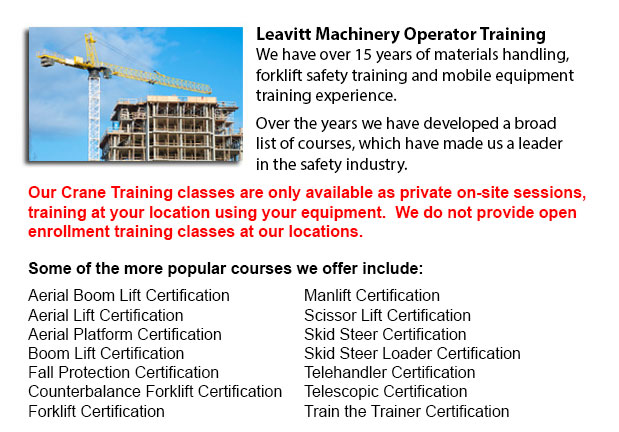
Prince George Crane Certification - The Crane Certification training program covers content suggested by industry about the safe and efficient operation of cranes. People training would know the following: how to identify cranes and their component parts; pre-operational, operational and post-operating requirements; how to determine overall lift capacity; rigging components and inspection/rejection criteria; and needs particular to the work site where the individuals training would be working.
The requirements which should be done prior to operating a crane includes assigning authority for the pre-operational check; doing the sequential pre-operational check based on the specifications certified by a professional engineer or manufacturer's specifications; checking the work place for obstacles and hazards; checking the log book for comments; checking chains, cables, hooks crane movement and safety latches; ensuring the right functioning of operational controls; and learning how to make sure that the crane's disconnect switch/isolator is properly working.
Operational requirements include identifying roles and responsibilities, and determining the need for a formal lift plan. Individuals training would be taught how to perform a danger assessment connected to environmental circumstances, physical circumstances and workers. Subject matter includes determining when to seek competent assistance, the destination of loads and the safest route, and centre of gravity and load weight.
Individuals training should be able to identify an over-capacity lift, in addition to be able to pick appropriate rigging equipment, select load limitations, and to determine the safe position for the crane to work from. Trainees will review both universal and site-specific crane signals for lifts, and techniques for traveling, lifting and loading. Appropriate maintenance habits will be included.
The individuals training will undergo an examination to test their knowledge of emergency response procedures for different conditions, particularly mechanical or electrical failures. They will be asked to describe parking and shut down procedures for security and safety, to follow tagging and lock out procedures, and to explain why near misses are recorded and reported to the appropriate individual. Log book records should be maintained.
The person training would learn the particulars of rigging, and learn the authority and responsibility for rigging. They will know to identify the different types of rigging, the load capacity ratings and storage procedures.
The requirements following operation of the crane will be taught also, learning to enter the deficiencies and defects; and to log the history of service and maintenance records, based on the federal, state and provincial codes requirements.
Site-specific needs could be included into the safety training program based on the employer's requirements.
-
Prince George Telehandler Operator Training
Prince George Telehandler Operator Training - Telehandler forklifts or Telescopic Handler forklifts are common industrial machines found in various construction industry settings. The telehandler is a useful machinery and makes for a valuable tool wh... More -
Skid Steer Loader Certification in Prince George
The engine powered skid-steer loader comprises a small and rigid frame, equipped with lift arms that could attach to many industrial attachments and tools to execute several labor saving tasks. Normally, skid-steer loaders are four-wheel drive vehicl... More -
Prince George Telehandler License
Prince George Telehandler License - The telescopic handler or telehandler is a generally utilized machine in agricultural and industrial applications. This machine is the same in look to a forklift and also works in a similar manner, although telehan... More -
Prince George Manlift Ticket
Prince George Manlift Ticket - The Elevated Platforms and Manlifts Certification course helps to provide the needed training on the work practices, safe operating procedures, rules and regulations regarding the everyday activities for the operators o... More -
Prince George Manlift Operator Training
Prince George Manlift Operator Training - A specialized kind of hydraulic platform is referred to as an aerial lift or a man lift. It is designed to hoist an individual vertically up and down and thus, is likewise called a vertical personnel lift. Th... More -
Prince George Forklift Safety Training
Prince George Forklift Safety Training - Individuals wanting work in industries that utilize forklifts have to undergo a forklift safety training course prior to becoming a certified operator of a lift truck. There are many ways to go about obtaining... More -
Prince George Boom Lift Certification
Prince George Boom Lift Certification - The use o elevated work platforms allow for maintenance operations and work to be performed at elevated work heights which were otherwise unreachable. Workers making use of boom lifts and scissor lifts could be... More -
Prince George Crane Training Schools
Prince George Crane Training Schools - We have designed various programs for Mobile Crane Operation at our Crane Training Schools. These programs are recommended for the skilled operator who needs certification or re-certification, and for inexperien... More

Forklift Certification Prince George
TOLL FREE: 1-888-254-6157
Prince George, British Columbia
forkliftcertificationprincegeorge.com
Email Us
About Us


